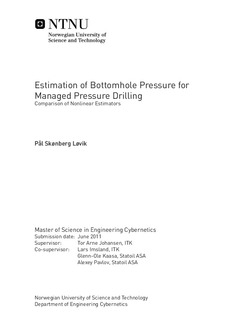Estimation of Bottomhole Pressure for Managed Pressure Drilling: Comparison of Nonlinear Estimators
Master thesis
Permanent lenke
http://hdl.handle.net/11250/260384Utgivelsesdato
2011Metadata
Vis full innførselSamlinger
Sammendrag
To avoid hole stability problems in an increasingly fierce drilling environment, the demand for accurate control of the pressure profile during drilling operations is rising. As standard instrumentation of drilling rigs have poor measurement of the bottom hole pressure, there is a need for estimation. However, a precise model of a drilling process is difficult to obtain, so a competent observer, using a simpler, lower order model, should be satisfactory.In this master thesis several approaches on estimation are discussed together with a suggested improvement in the annular friction model. The estimators tested are: First, the moving horizon observer, which is presented together with prior work by the author and Marcel Paasche; Second, the unscented Kalman filter, which is a new estimation candidate introduced together with regularization to compensate for the slow update and lack of availability in bottom hole pressure measurements. Last, different combinations of the two observers are proposed.All observers are tested in simulations and good performance is found for both the MHE and UKF. Parameter adaptation is found to be effective for both observers, but the UKF encounters some minor observability issues when the system is not sufficiently exciting. Different combinations of the two observers increase computational complexity, unfortunately without achieving better accuracy in estimates. The estimates are deteriorated when the alternative friction model is tested, and it is thus considered a failed attempt to improve the simple third order Kaasa model.
